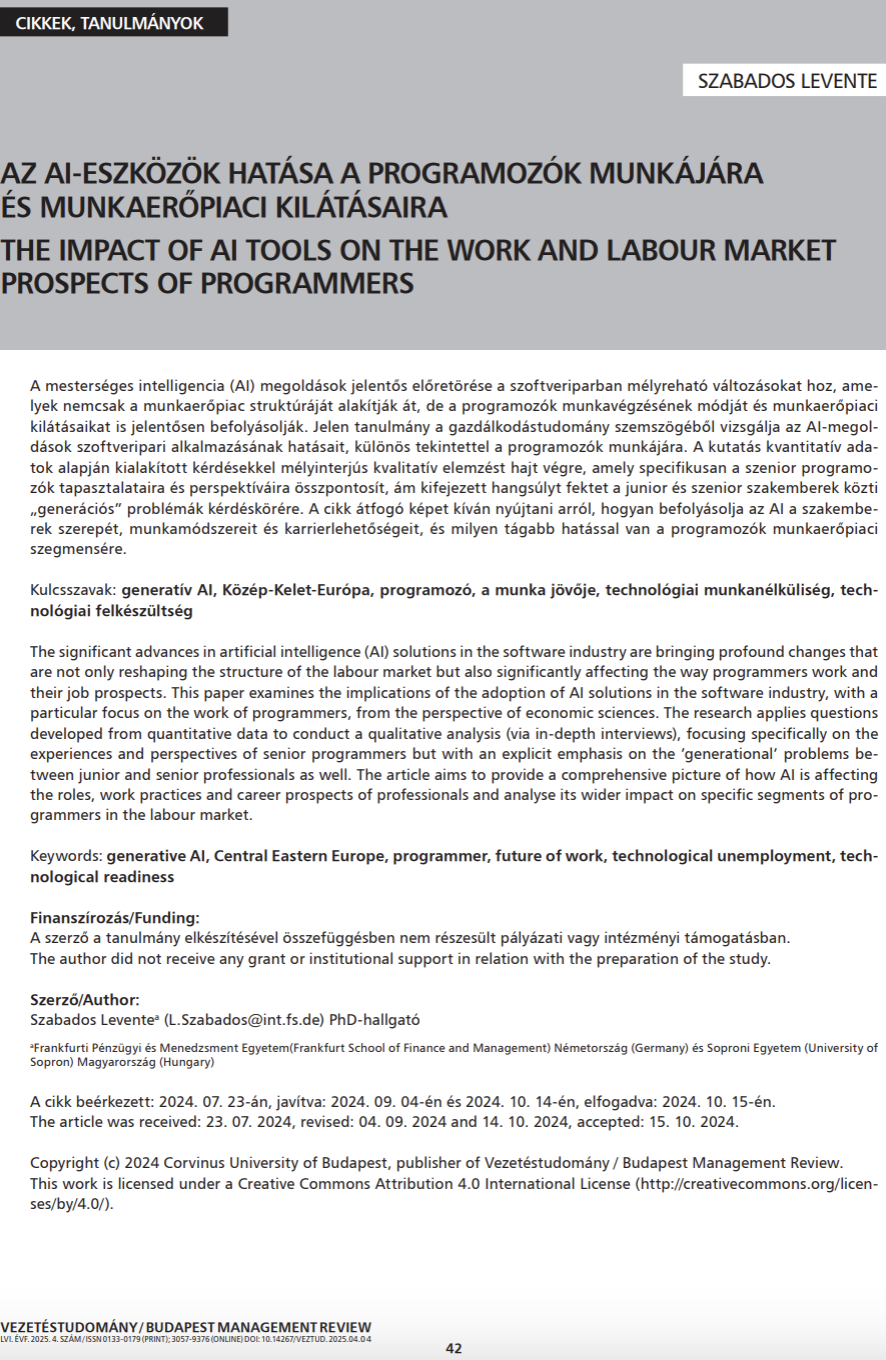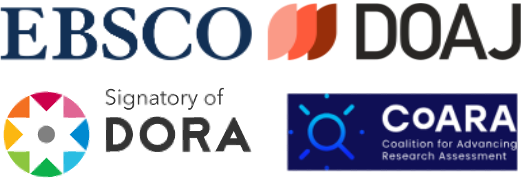The impact of AI tools on the work and labour market prospects of programmers
DOI:
https://doi.org/10.14267/VEZTUD.2025.04.04Keywords:
generative AI, Central Eastern Europe, programmer, future of work, technological unemployment, technological readinessAbstract
The significant advances in artificial intelligence (AI) solutions in the software industry are bringing profound changes that are not only reshaping the structure of the labour market but also significantly affecting the way programmers work and their job prospects. This paper examines the implications of the adoption of AI solutions in the software industry, with a particular focus on the work of programmers, from the perspective of economic sciences. The research applies questions developed from quantitative data to conduct a qualitative analysis (via in-depth interviews), focusing specifically on the experiences and perspectives of senior programmers but with an explicit emphasis on the ’generational’ problems between junior and senior professionals as well. The article aims to provide a comprehensive picture of how AI is affecting the roles, work practices and career prospects of professionals and analyse its wider impact on specific segments of programmers in the labour market.
Downloads
References
Agrawal, A., Gans, J., & Goldfarb, A. (2018). Prediction machines: The simple economics of artificial intelligence. Harvard Business Review Press.
Agrawal, A., Gans, J., & Goldfarb, A. (2022). Power and prediction: The disruptive economics of artificial intelligence. Harvard Business Review Press.
Bessen J.E. (2017) AI and jobs: The role of demand. (NBER Working Paper No. 24235). National Bureau of Economic Research. https://doi.org/10.3386/w24235
Bommasani, R., Hudson, D.A., Adeli, E., Altman, R., Arora, S., von Arx, S., Bernstein, M.S., Bohg, J., Bosselut, A., Brunskill, E., Brynjolfsson, E., Buch, S., Card, D., Castellon, R., Chatterji, N., Chen, A., Creel, K., Davis, J. Q., Demszky, D., … Liang, P. (2022). On the opportunities and risks of foundation models. arXiv. https://doi.org/10.48550/arXiv.2108.07258
Brauner P., Hick A., Philipsen R., & Ziefle M. (2023). What does the public think about artificial intelligence? — A criticality map to understand bias in the public perception of AI. Frontiers of Computer Science, 5, 1113903. https://doi.org/10.3389/fcomp.2023.1113903
Bughin J., Seong J., Manyika J., Chui M., & Joshi R. (2018). Notes from the AI frontier: Modeling the impact of AI on the world economy. Discussion paper. McKinsey Global Institute. https://www.mckinsey.com/~/media/McKinsey/Featured%20Insights/Artificial%20Intelligence/Notes%20from%20the%20frontier%20Modeling%20the%20impact%20of%20AI%20on%20the%20world%20economy/MGI-Notes-from-the-AIfrontier-Modeling-the-impact-of-AI-on-the-worldeconomy-September-2018.ashx
Dechter, R. (1986). Learning while searching in constraint- satisfaction-problems. In Proceedings of the AAAI Conference on Artificial Intelligence (pp. 178- 183). ACM. https://dl.acm.org/doi/abs/10.5555/2887770.2887799
DeepMind (2024). Gemini v1.5: Technical report. https://deepmind.google/technologies/gemini/
Dell’Acqua, F., Rajendran, S., McFowland, E., Krayer, L., Mollick, E., Candelon, F., Lifshitz-Assaf, H., Lakhani, K., & Kellogg C. (2023). Navigating the jagged technological frontier: Field experimental evidence of the effects of AI on knowledge worker productivity and quality. Harvard Business School Technology & Operations Mgt. Unit Working Paper No. 24-013. The Wharton School Research Paper. https://doi.org/10.2139/ssrn.4573321
Developer Nation. (2024). State of the developer nation 26th edition: Developer trends for Q3 2024. https://www.developernation.net/developer-reports/dn26/
Felten, E.W., Raj, M., & Seamans, R. (2019). The occupational impact of artificial intelligence: Labor, skills, and polarization. Technical report. NYU Stern School of Business. https://dx.doi.org/10.2139/ssrn.3368605
Felten, E, Raj, M., & Seamans, R. (2021). Occupational, industry, and geographic exposure to artificial intelligence: A novel dataset and its potential uses. Strategic Management Journal 42(12), 2195–2217. https://doi.org/10.1002/smj.3286
Fradkov, A.L. (2020). Early history of machine learning. IFAC-PapersOnLine, 53(2), 1385–1390. https://doi.org/10.1016%2Fj.ifacol.2020.12.1888
Galster, M., Mitrovic, A., Malinen, S., & Holland, J. (2022). What soft skills does the software industry really want? An exploratory study of software positions in New Zealand. In Proceedings of the ACM/IEEE International Symposium on Empirical Software Engineering and Measurement (ESEM ‚22) (pp. 1-11). ACM. https://doi.org/10.1145/3544902.3546247
Huang, L., Yu, W., Ma, W., Zhong, W., Feng, Z., Wang, H., Chen, Q., Peng, W., Feng, X., Qin, B., & Liu, T. (2023). A survey on hallucination in large language models: Principles, taxonomy, challenges, and open questions. arXiv. https://doi.org/10.48550/arXiv.2311.05232
Inc., S.E. (2024). Stack overflow – where developers learn, share, & build careers. https://stackoverflow.com/
Kovács, L., & Vastag, E. (2023). Magyar szoftverfejlesztők bérkülönbségeinek elemzése a Stack Overf low kérdőíve alapján. Statisztikai Szemle, 101(11), 9 47-977. https://doi.org/10.20311/stat2023.11.hu0947
Laato, S., Mäntymäki, M., Islam, N., Hyrynsalmi, S., & Birkstedt, T. (2022). Trends and trajectories in the software industry: Implications for the future of work. Information Systems Frontiers, 25(3), 1-16. https://doi.org/10.1007/s10796-022-10267-4
Lee, K. (2021). Economics of technological leapfrogging. In The challenges of technology and economic catch-up in emerging economies (pp. 123-159). Oxford University Press. http://dx.doi.org/10.1093/oso/9780192896049.003.0005
Lexique (2024, March 24). Hackathon jelentése. https://lexiq.hu/hackathon
McCarthy, J., Minsky, M., Rochester, N., & Shannon, C. (1955). A proposal for the Dartmouth Summer Research Project on Artificial Intelligence. https://www.formal.stanford.edu/jmc/history/dartmouth/dartmouth.html
Nagyné Halász, Zs. (2023). Az IT szakember-képzés és a piaci kompetencia-elvárások közötti diszharmónia feloldásának lehetőségei. GIKOF Journal https://doi.org/10.14267/GIKOF.2024.02
Naimi, L., Bouziane, E.M., & Jakimi, A. (2024). Automating test case generation from class diagram using generative AI. In M. Serrhini & K. Ghoumid (Eds.), Advances in smart medical, IoT & artificial intelligence (Vol. 11) (pp. 133–140). Springer. https://doi.org/10.1007/978-3-031-66850-0_15
Ogedengbe, F.A., Talib, Y.Y.A., & Rusly, F.H. (2024). Influence of structural factors on employee cloud shadow it usage during covid-19 lockdown: a strain theory perspective. Cognition, Technology and Work, 26(1), 63–81. http://dx.doi.org/10.1007/s10111-023-00748-0
Petrovska, O., Clift, L., Moller, F., & Pearsall, R. (2024). Incorporating generative AI into software development education. Proceedings of the 8th Conference on Computing Education Practice (CEP ‚24) (pp. 37-40). https://doi.org/10.1145/3633053.3633057
Scheffler, I. (2023 June 17). Github ceo says copilot will write 80% of code „sooner than later”. Freethink. https://www.freethink.com/robots-ai/github-copilot
Stack Overflow. (2023a). 2023 stack overflow developer survey. https://survey.stackoverflow.co/2023
Stack Overflow. (2023b). Developer sentiment around ai/ml. https://stackoverflow.co/labs/developer-sentiment-ai-ml/
Statista Research Department. (2016). Share of mobile app developers worldwide in 2014, by country. Statista. https://www.statista.com/statistics/256629/share-ofandroid-app-developers-worldwide-by-country/
Szabados, L. (2024a). AI’s effect on labour: What does economic literature say? The International Journal of Engineering and Science, 13(5), 328-350 https://doi.org/10.9790/1813-1305328350
Szabados, L. (2024b). The dynamics of AI adoption: Book review: Power and prediction: The disruptive economics of artificial intelligence. Alma Mater, 1, [megjelenés alatt].
U.S. Bureau of Labor Statistics. (2023). Occupational employment and wages, May 2022: Software developers (15-1252). U.S. Department of Labor. https://www.bls.gov/oes/current/oes151252.htm
Zippia. (2024). Freelance software developer demographics and statistics in the US. https://www.zippia.com/freelance-software-developer-jobs/demographics/

Downloads
Published
How to Cite
Issue
Section
License
Copyright (c) 2025 Corvinus University of Budapest, publisher of Vezetéstudomány / Budapest Management Review

This work is licensed under a Creative Commons Attribution 4.0 International License.
Authors assign copyright to Vezetéstudomány / Budapest Management Review. Authors are responsible for permission to reproduce copyright material from other sources.

